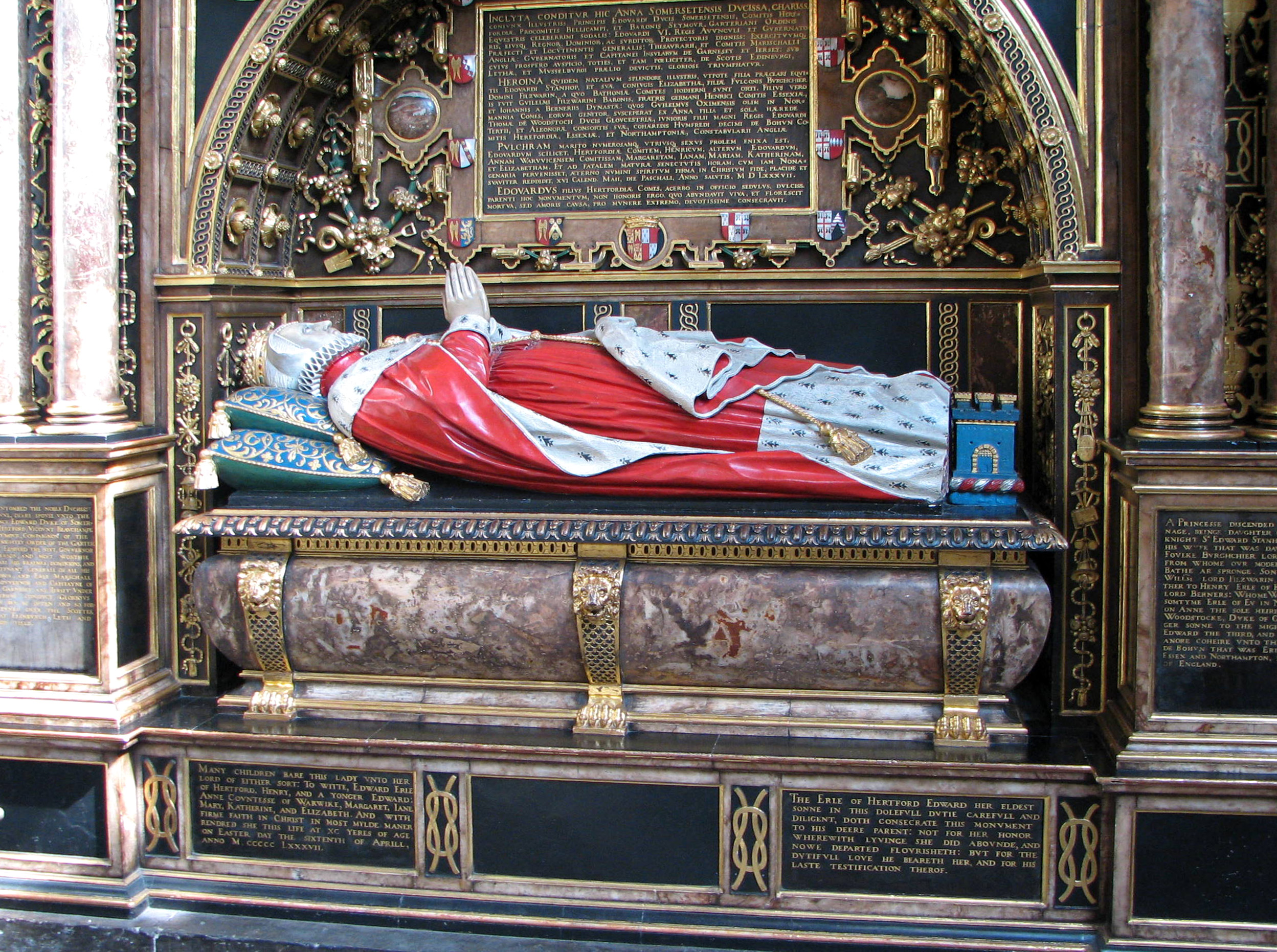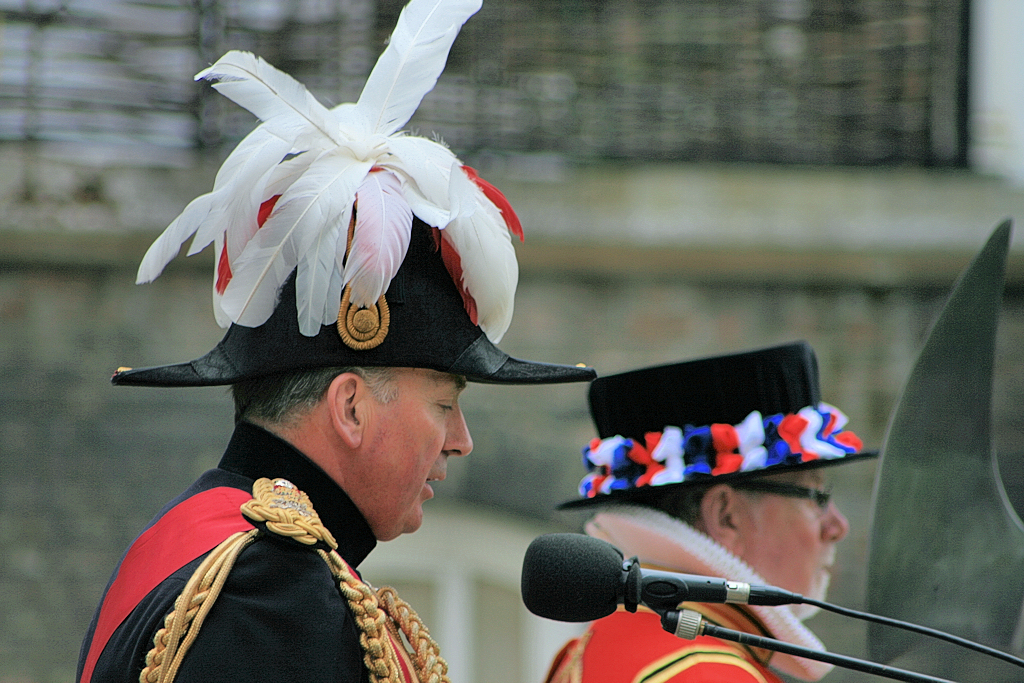|
Elizabeth Bourchier (died 1557)
Elizabeth Bourchier (before 1473 – 8 August 1557) was an English noblewoman. She was, by her third husband, Sir Edward Stanhope, the mother of Anne Stanhope, wife of the Protector Somerset. Her fourth husband was the courtier Sir Richard Page. She died in 1557, and was buried at Clerkenwell. Life Elizabeth Bourchier (before 1473 – 8 August 1557) was daughter of Fulk Bourchier, 10th Baron FitzWarin (25 October 1445 – 18 September 1479). Elizabeth Bourchier's mother was Elizabeth Dynham (d. 19 October 1516).. She was the daughter of Sir John Dynham (d. 25 January 1458) by Joan Arches (d.1497), and the sister and coheir of John Dynham, 1st Baron Dynham (d. 1501). After the death of her first husband, Fulk Bourchier, she married Sir John Sapcotes (d.1501) of Elton, Huntingdonshire, and after his death, Sir Thomas Brandon (d. 27 January 1510) of Duddington, Northamptonshire. There were no issue of Elizabeth Dynham's marriage to Thomas Brandon, and according to Gunn, after his ... [...More Info...] [...Related Items...] OR: [Wikipedia] [Google] [Baidu] |
Anne Seymour, Duchess Of Somerset
Anne Seymour, Duchess of Somerset (née Stanhope; before 1512 – 16 April 1587) was the second wife of Edward Seymour, 1st Duke of Somerset (c. 1500–1552), who held the office of lord protector during the first part of the reign of their nephew King Edward VI. The Duchess was briefly the most powerful woman in England. During her husband's regency she unsuccessfully claimed precedence over the queen dowager, Catherine Parr. Family Anne Stanhope was likely born in 1510, the only child of Sir Edward Stanhope (1462 – 6 June 1511) by his wife Elizabeth Bourchier (b. before 1473, d. 1557), a daughter of Fulk Bourchier, 10th Baron FitzWarin (1445–1479). By her father's first marriage to Adelina Clifton she had two half-brothers, Richard Stanhope (died 1529) and Sir Michael Stanhope. After the death of Sir Edward Stanhope in 1511, his widow, Elizabeth, married Sir Richard Page of Beechwood, Hertfordshire. Her paternal grandparents were Thomas Stanhope, esquire, of Shelfo ... [...More Info...] [...Related Items...] OR: [Wikipedia] [Google] [Baidu] |
Henry Machyn
Henry Machyn (1496/1498 – 1563) was an English clothier and diarist in 16th century London. Machyn's ''Chronicle'', which was written between 1550 and 1563, is primarily concerned with public events: changes on the throne, state visits, insurrections, executions and festivities. Machyn wrote his diary during a turbulent period in England: the Reformation, initiated by Henry VIII and carried through by Edward VI, was followed by the return to Catholicism (and burning of heretics) under Queen Mary I of England. Judging from his enthusiastic account of the disinterment of Edward the Confessor in 1557, Machyn was apparently a Catholic himself. The brief reign of Lady Jane Grey, and the dangers of speaking up for the losing side, are duly recorded. He circulated libellous information about the Protestant preacher John Véron, for which he made penance at Paul's Cross St Paul's Cross (alternative spellings – "Powles Crosse") was a preaching cross and open-air pulpit in the ... [...More Info...] [...Related Items...] OR: [Wikipedia] [Google] [Baidu] |
Tower Of London
The Tower of London, officially His Majesty's Royal Palace and Fortress of the Tower of London, is a historic castle on the north bank of the River Thames in central London. It lies within the London Borough of Tower Hamlets, which is separated from the eastern edge of the square mile of the City of London by the open space known as Tower Hill. It was founded towards the end of 1066 as part of the Norman Conquest. The White Tower (Tower of London), White Tower, which gives the entire castle its name, was built by William the Conqueror in 1078 and was a resented symbol of oppression, inflicted upon London by the new Normans, Norman ruling class. The castle was also used as a prison from 1100 (Ranulf Flambard) until 1952 (Kray twins), although that was not its primary purpose. A grand palace early in its history, it served as a royal residence. As a whole, the Tower is a complex of several buildings set within two concentric rings of defensive walls and a moat. There were severa ... [...More Info...] [...Related Items...] OR: [Wikipedia] [Google] [Baidu] |
Mary I Of England
Mary I (18 February 1516 – 17 November 1558), also known as Mary Tudor, and as "Bloody Mary" by her Protestant opponents, was Queen of England and Ireland from July 1553 and Queen of Spain from January 1556 until her death in 1558. She is best known for her vigorous attempt to reverse the English Reformation, which had begun during the reign of her father, Henry VIII. Her attempt to restore to the Church the property confiscated in the previous two reigns was largely thwarted by Parliament, but during her five-year reign, Mary had over 280 religious dissenters burned at the stake in the Marian persecutions. Mary was the only child of Henry VIII by his first wife, Catherine of Aragon, to survive to adulthood. Her younger half-brother, Edward VI, succeeded their father in 1547 at the age of nine. When Edward became terminally ill in 1553, he attempted to remove Mary from the line of succession because he supposed, correctly, that she would reverse the Protestant refor ... [...More Info...] [...Related Items...] OR: [Wikipedia] [Google] [Baidu] |
William Skipwith (died 1586)
Sir William Skipwith (by 1510 – 17 October 1586) was an English politician. He was born the eldest son of Sir William Skipwith and his first wife Elizabeth Tyrwhitt. He was admitted in 1527 to study law at Grays Inn. Skipwith married Elizabeth Page, the daughter of Sir Richard Page of Beechwood, Hertfordshire, and Elizabeth Bourchier, by whom he had a son and five daughters. He succeeded his father in 1547 and was knighted later the same year. He was elected a Member of Parliament (MP) to represent Lincolnshire in 1547. He was appointed High sheriff of Lincolnshire for 1552–53 and 1563–64 and Justice of the Peace (JP) for Lindsey from 1554 to 1572. He died on 17 October 1586 at Hanby, Lincolnshire, and was buried at South Ormsby. References * {{DEFAULTSORT:Skipwith, William 16th-century births 1586 deaths English MPs 1547–1552 High Sheriffs of Lincolnshire William William is a male given name of Germanic origin.Hanks, Hardcastle and Hodges, ''Oxford Dicti ... [...More Info...] [...Related Items...] OR: [Wikipedia] [Google] [Baidu] |
Westminster Abbey Tomb
Westminster is an area of Central London, part of the wider City of Westminster. The area, which extends from the River Thames to Oxford Street, has many visitor attractions and historic landmarks, including the Palace of Westminster, Buckingham Palace, Westminster Abbey, Westminster Cathedral and much of the West End shopping and entertainment district. The name ( ang, Westmynstre) originated from the informal description of the abbey church and royal peculiar of St Peter's (Westminster Abbey), west of the City of London (until the English Reformation there was also an Eastminster, near the Tower of London, in the East End of London). The abbey's origins date from between the 7th and 10th centuries, but it rose to national prominence when rebuilt by Edward the Confessor in the 11th. Westminster has been the home of England's government since about 1200, and from 1707 the Government of the United Kingdom. In 1539, it became a city. Westminster is often used as a metonym t ... [...More Info...] [...Related Items...] OR: [Wikipedia] [Google] [Baidu] |
Sandal Castle
Sandal Castle is a ruined Middle Ages, medieval castle in Sandal Magna, a suburb of the city of Wakefield in West Yorkshire, England, overlooking the River Calder, West Yorkshire, River Calder. It was the site of royal intrigue and the setting for a scene in one of William Shakespeare's plays. History The Warennes William de Warenne, 2nd Earl of Surrey (1081–1138) was granted the Sandal estates in 1107. The 2nd earl built the first Sandal Castle of timber. He supported Robert Curthose against Henry I and was banished from the kingdom for two years. Later he was given the Wakefield manor. William de Warenne, 3rd Earl of Surrey (1119–1148) spent little time at Sandal, having taken crusading vows and joined the Second Crusade. He had one daughter, Isabel de Warenne, 4th Countess of Surrey, Isabel de Warenne (1137–1199), who married William I, Count of Boulogne, William of Blois, son of King Stephen, who became the 4th earl. He died in 1159, leaving no children. Isabel, his w ... [...More Info...] [...Related Items...] OR: [Wikipedia] [Google] [Baidu] |
Constable
A constable is a person holding a particular office, most commonly in criminal law enforcement. The office of constable can vary significantly in different jurisdictions. A constable is commonly the rank of an officer within the police. Other people may be granted powers of a constable without holding this title. Etymology Historically, the title comes from the Latin ''comes stabuli'' ( attendant to the stables, literally ''count of the stable'') and originated from the Roman Empire; originally, the constable was the officer responsible for keeping the horses of a lord or monarch.p103, Bruce, Alistair, ''Keepers of the Kingdom'' (Cassell, 2002), Constable Encyclopædia Britannica online The title was imported to the monarchy, monarchies of Middle Ages, medieval Europe, and in many countries developed into a high military rank an ... [...More Info...] [...Related Items...] OR: [Wikipedia] [Google] [Baidu] |
Battle Of Stoke
The Battle of Stoke Field on 16 June 1487 may be considered the last battle of the Wars of the Roses, since it was the last major engagement between contenders for the throne whose claims derived from descent from the houses of Lancaster and York respectively. The Battle of Bosworth Field, two years previously, had established King Henry VII on the throne, ending the last period of Yorkist rule and initiating that of the Tudors. The Battle of Stoke Field was the decisive engagement in an attempt by leading Yorkists to unseat him in favour of the pretender Lambert Simnel. Though it is often portrayed as almost a footnote to the major battles between York and Lancaster, it may have been slightly larger than Bosworth, with much heavier casualties, possibly because of the terrain which forced the two sides into close, attritional combat. In the end, though, Henry's victory was crushing. Almost all the leading Yorkists were killed in the battle. The pretender Henry VII of England he ... [...More Info...] [...Related Items...] OR: [Wikipedia] [Google] [Baidu] |






